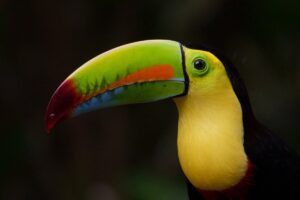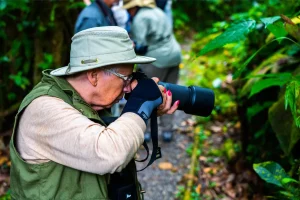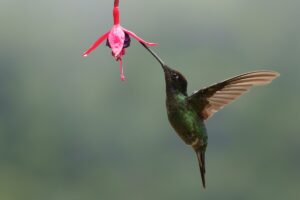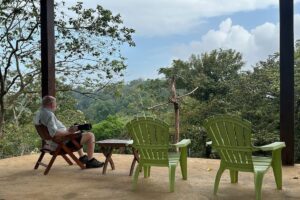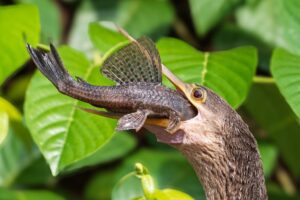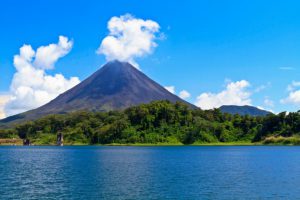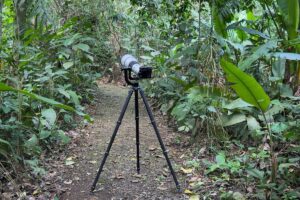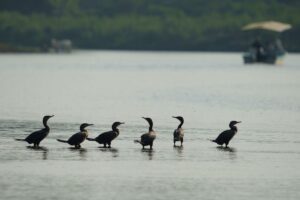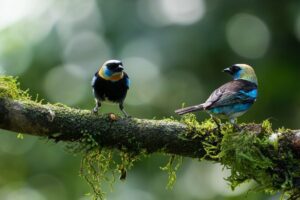Hummingbird photography is a delightful pursuit that combines the thrill of birdwatching with the art of capturing these tiny, vibrant creatures in flight. Costa Rica, known for its rich biodiversity, offers an unparalleled experience for photographers aiming to capture the beauty of hummingbirds in their natural habitat.
Species of Hummingbirds in Costa Rica
Costa Rica is home to over 50 species of hummingbirds, each with unique characteristics and vibrant colors. Notable species include the Violet-crowned Woodnymph, the Fiery-throated Hummingbird, and the Coppery-headed Emerald, which is endemic to Costa Rica.
Costa Rica is home to a stunning array of hummingbird species. Here is a comprehensive list of the hummingbird species that can be found in Costa Rica:
- Green-crowned Brilliant (Heliodoxa jacula)
- Violet-crowned Woodnymph (Thalurania colombica)
- Fiery-throated Hummingbird (Panterpe insignia)
- Coppery-headed Emerald (Elvira cupreiceps) – Endemic to Costa Rica
- Black-bellied Hummingbird (Eupherusa nigriventris)
- Purple-throated Mountain-gem (Lampornis calolaemus)
- White-throated Mountain-gem (Lampornis castaneoventris)
- Stripe-tailed Hummingbird (Eupherusa eximia)
- Volcano Hummingbird (Selasphorus flammula)
- Rufous-tailed Hummingbird (Amazilia tzacatl)
- Blue-throated Goldentail (Hylocharis eliciae)
- Snowy-bellied Hummingbird (Amazilia edward)
- Steely-vented Hummingbird (Amazilia saucerrottei)
- Cinnamon Hummingbird (Amazilia rutila)
- Mangrove Hummingbird (Amazilia boucardi) – Endemic to Costa Rica
- Scintillant Hummingbird (Selasphorus scintilla)
- Magenta-throated Woodstar (Calliphlox bryantae)
- Green-breasted Mango (Anthracothorax prevostii)
- Long-billed Starthroat (Heliomaster longirostris)
- Plain-capped Starthroat (Heliomaster constantii)
- Canivet’s Emerald (Chlorostilbon canivetii)
- Violet-headed Hummingbird (Klais guimeti)
- Bronze-tailed Plumeleteer (Chalybura urochrysia)
- White-necked Jacobin (Florisuga mellivora)
- Green Hermit (Phaethornis guy)
- Long-billed Hermit (Phaethornis longirostris)
- Stripe-throated Hermit (Phaethornis striigularis)
- Band-tailed Barbthroat (Threnetes ruckeri)
- Purple-crowned Fairy (Heliothryx barroti)
- Brown Violet-ear (Colibri delphinae)
- Green Violet-ear (Colibri thalassinus)
- Lesser Violet-ear (Colibri cyanotus)
- Talamanca Hummingbird (Eugenes spectabilis)
- Magnificent Hummingbird (Eugenes fulgens)
- Garden Emerald (Chlorostilbon assimilis)
Behavior and Habitat
Hummingbirds are known for their incredible flight capabilities, including hovering and flying backwards. They primarily inhabit areas rich in flowering plants, such as cloud forests, gardens, and rainforests, where they feed on nectar.
Best Locations for Hummingbird Photography in Costa Rica
Sarapiquí
Known for its rich birdlife, Sarapiquí offers lush rainforests and gardens teeming with hummingbirds. The area is less crowded, providing a serene environment for photography. Species you might encounter include the Rufous-tailed Hummingbird and the Violet-crowned Woodnymph.
San Gerardo de Dota
This highland region is famous for its population of the Resplendent Quetzal, but it also hosts several hummingbird species. The cooler climate and abundant flowering plants make it a perfect habitat for species like the Magnificent Hummingbird and the Fiery-throated Hummingbird.
Cachi
Located in the Orosi Valley, Cachi offers a diverse ecosystem with many flowering plants that attract hummingbirds. Photographers can capture species such as the Scintillant Hummingbird and the Snowy-bellied Hummingbird in this picturesque setting.
Cerro de la Muerte
This high-altitude location is part of the Talamanca Mountain Range and is known for its unique avian diversity. Hummingbirds like the Volcano Hummingbird and the Talamanca Hummingbird can be seen darting among the flora in this rugged terrain.
La Zona de los Santos
This region is renowned for its coffee plantations and cool, misty environment. It’s a lesser-known spot for birdwatching, offering sightings of hummingbirds like the White-throated Mountain-gem and the Stripe-tailed Hummingbird.
15 interesting facts about hummingbirds
- In Costa Rica, there are 53 species of hummingbirds, mainly found at medium and high elevations throughout the country. Their wings can beat around 60 times per second. Hummingbirds feed on flower nectar, consuming about three times their body weight every day. While they primarily drink sugary nectar, they also get protein from small insects.
- Hummingbirds are incredibly smart! They have the largest brain-to-body size ratio of any bird. Their hearts can beat up to 1,200 times per minute. Despite their intelligence and fascinating biology, most hummingbirds have a very short lifespan, often not living longer than a single year. Those that survive usually live up to 4 years, although in captivity, they can live for 15-17 years.
- These tiny birds spend more than half of their time preening, chirping, or at rest. Their muscles enable them to reach astonishing speeds of 50 to 95 km/h when diving during courtship. The horned sungem holds the record for the fastest wingbeat, at 90 times per second, a speed confirmed by the Guinness Book of Records.
- Despite their small size and high metabolism, hummingbirds have an energy-saving mechanism that allows them to lower their body temperature from 37.5°C to 17°C by reducing their activity. At rest, their heart rate is 500-600 beats per minute, but it can exceed 1,000 beats per minute when they are excited during disputes with other hummingbirds.
- Hummingbirds have big hearts, literally, with the heart making up 2.5% of their total body weight. These species are endemic to the Americas, meaning they are found only in this region and nowhere else. The bee hummingbird, living in Cuba, is the world’s smallest bird, measuring 5 to 6 cm and weighing 1.5-1.9 grams. The largest hummingbird is the giant hummingbird, which lives in South America and measures 8 inches in size.
Preparing for Your Photography Tour
Essential Gear for Hummingbird Photography
- Cameras and lenses. For capturing the intricate details of hummingbirds, a DSLR or mirrorless camera with a fast autofocus system is ideal. Lenses with a focal length of 300mm or more are recommended to get close-up shots without disturbing the birds.
- Accessories. Tripods, especially those with a gimbal head, provide stability for long shooting sessions. Flashes with diffusers can help illuminate hummingbirds in low light conditions, enhancing their iridescent feathers.
- Clothing and personal Items. Wear lightweight, breathable clothing suitable for tropical climates. Long sleeves and pants can help protect against insects and sun exposure. Don’t forget essentials like sunscreen, a hat, and comfortable walking shoes.
Techniques for Capturing Stunning Hummingbird Photos
- Understanding light and Timing. Early mornings and late afternoons provide the best natural light for photography. The soft light during these times highlights the iridescent feathers of hummingbirds without harsh shadows.
- Using the Right Settings:
- Shutter Speed. A fast shutter speed, typically 1/2000th of a second or faster, is essential to freeze the rapid wing movements of hummingbirds.
- Aperture. A wide aperture (low f-stop number) helps create a shallow depth of field, making the hummingbird stand out against a blurred background.
- Approaching Hummingbirds. Move slowly and patiently to avoid startling the birds. Using feeders or planting nectar-rich flowers can attract hummingbirds to a specific area, making it easier to photograph them.
Post-Processing Tips for Hummingbird Photos
- Basic editing techniques. Start with basic adjustments like cropping, exposure, and contrast to enhance your images. Use editing software like Adobe Lightroom or Photoshop for more detailed work.
- Enhancing colors and details. Boost the vibrancy and saturation to make the colors of the hummingbird pop. Sharpening tools can help bring out fine details in the feathers.
Ethical Considerations in Hummingbird Photography
Respecting Wildlife and Their Habitat
Always prioritize the well-being of the birds and their environment. Avoid using flash excessively, as it can startle and stress the birds.
Minimizing Disturbance
Keep a respectful distance and avoid making loud noises or sudden movements. Be mindful of your impact on the habitat, sticking to established paths and avoiding trampling vegetation.
Conclusion
Hummingbird photography in Costa Rica offers an unforgettable experience, combining the thrill of capturing these agile birds with the beauty of the country’s diverse ecosystems.
With the right preparation and techniques, you can take stunning photos while respecting the natural environment. So pack your gear, head to Costa Rica, and immerse yourself in the magical world of hummingbird photography.
FAQs
What is the best time of year to photograph hummingbirds in Costa Rica?
The dry season from December to April is ideal, as the weather is more predictable and many hummingbirds are in full breeding plumage.
How close can I get to hummingbirds without disturbing them?
It’s best to maintain a distance of at least 10–15 feet to avoid stressing the birds. Using a telephoto lens can help you get close-up shots without disturbing them.
What settings should I use for hummingbird photography?
Use a fast shutter speed (1/2000th of a second or faster), a wide aperture (low f-stop), and an ISO setting that balances exposure without introducing too much noise.
Are there guided tours specifically for hummingbird photography in Costa Rica?
Yes, many tour operators in Costa Rica offer guided photography tours focused on hummingbirds and other wildlife, providing expert guidance and access to prime locations.
Can I use a smartphone for hummingbird photography?
While smartphones can capture decent photos, they lack the zoom capabilities and fast shutter speeds needed for high-quality hummingbird photography. A DSLR or mirrorless camera is recommended for the best results.

